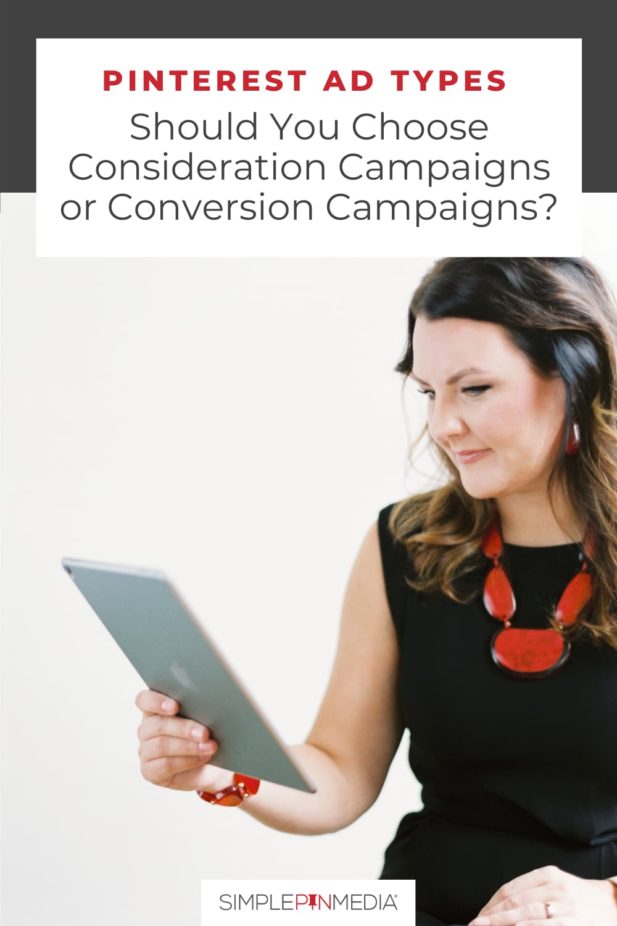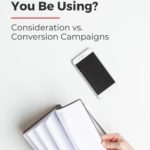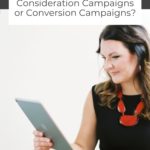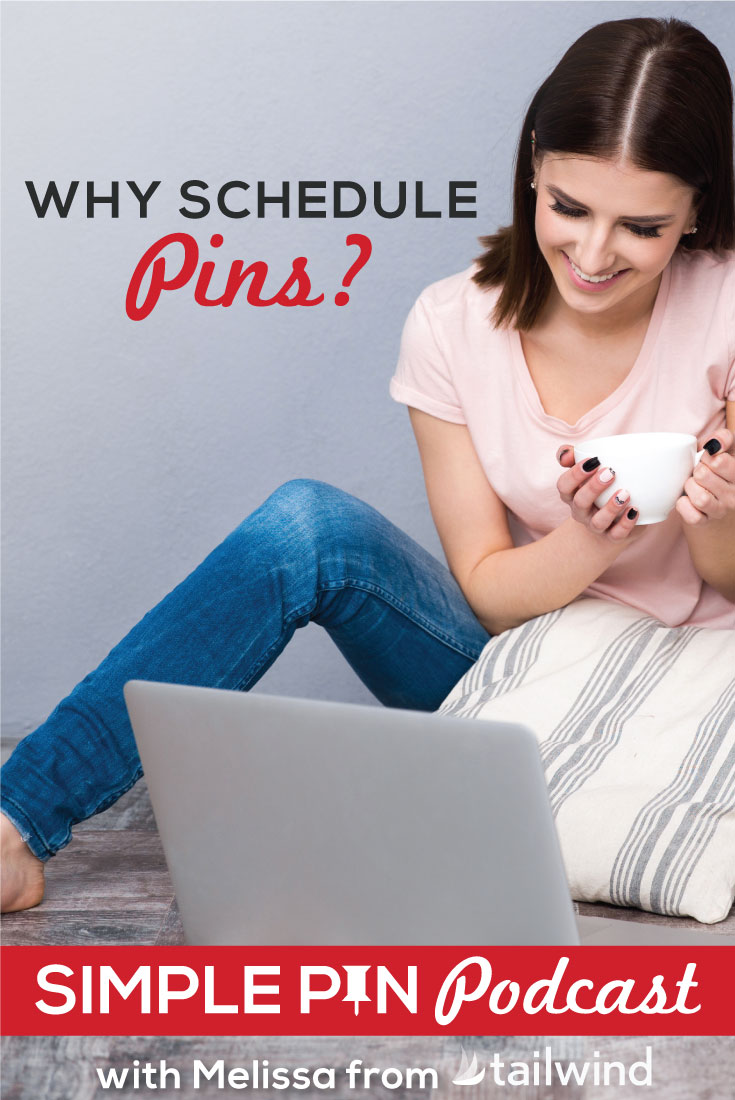When it’s time for you to consider running an ad campaign for your business, how do you know which direction to take? Pinterest currently offers two different types of Pinterest ads. Choosing the right type of campaign can be confusing if you’re new to the Pinterest ads arena.
You may be wondering what the difference is between a consideration campaign and a conversion campaign. How do you choose which type of Pinterest ad is best for your business? How can you be sure you’re spending your ad campaign budget wisely? What is the best choice for you and your business?
In this episode, we offer up some expert advice to help you answer all these questions and more!
Our Director of Pinterest Ads Management, Erin Harding, takes the mic to talk about Pinterest Ads Campaigns. Erin’s guest today is Emilee Vales. Emilee is a former teacher turned Pinterest marketing and ads expert who has built her own business from the ground up promoting Pins and running ad campaigns on the Pinterest platform.

Before we begin, it’s worth noting a couple of terminology and function changes in the ads dashboard that Pinterest recently rolled out. Here’s an overview of the most relevant changes for our discussion:
- Traffic Objective Campaigns have now been renamed to Consideration Campaigns
- There have been some updates to Pinterest metrics:
- Link Clicks have been renamed to Pin Clicks to provide clarity on the actions taking place on Pinterest
- Outbound Clicks is a new metric that provides more granular reporting on the number of clicks to your destination URL
- The ad experience has been updated so your website loads after an outbound click to help you see audience value through improvements to bounce rates and 3rd party analytics tracking.
- Metrics terminology is being updated so organic metrics will mirror paid metrics.
- Budgeting for the Consideration Objective is being enhanced
Types of Pinterest Ads
What Type of Pinterest Ad Campaign Should You Run?
Pinterest allows you to run different types of ad campaigns. Choosing the right one might seem obvious by the name, but is that true? If you’re just getting started with Promoted Pins (aka Pinterest ads), you’re probably thinking:
I want to get conversions. That means starting with a conversion campaign, right?
Obviously, we all want to increase our conversions, but a conversion campaign may not be the best option for you. Your best choice might be a consideration campaign (previously called traffic objectives campaign).
Making sure Pinterest is receiving and understanding information from your website correctly is vital to any campaign. Running a consideration campaign can be a really solid place to start getting your Pinterest tag “warmed up” and start informing Pinterest about your audience (especially if you’re on a smaller budget).
Running a consideration campaign does not mean you won’t be able to see conversions. A consideration campaign helps drive those outbound clicks you’re looking for and you will still be able to track conversions.
What are the Benefits of a Consideration Campaign?
They’re Less “Temperamental” – Consideration campaigns are less “temperamental” than conversion campaigns. They are pretty forgiving. There is room to make some beginner mistakes that don’t require that you completely reset your campaign.
They Ease You Into Promoted Pins – With a consideration campaign, you can start a little slower and get some great experience interacting with the Pinterest ads dashboard. It’s nice to start slow, especially when you’re spending money every day.
They are Less Expensive to Run – With a consideration campaign, you are paying per click. With a conversion campaign, you’re technically paying a dollar amount per thousand impressions. Your ad dollars can spend down quickly in a conversion campaign.
They are a Great Place to Target Your Audience – There are some benchmarks that are important to hit and audience information that is vital to collect before incurring the cost of a conversion campaign. Information you nail down in a consideration campaign can help you really target your audience for a conversion campaign.
If you’re just getting started it can get a little scary to see how quickly your ad budget disappears. Consideration campaigns optimize faster, giving you results more quickly and at a lower price.
How Do You Choose Between the Two Types of Pinterest Ads?
It’s important to keep your objectives in mind. Here are some important questions to ask yourself:
- Do you just need to create awareness?
- Are you promoting your pin to a landing page?
- Are you promoting to a sales page?
- How much money are you willing to pay to get the results you want?
As you consider your investment, remember that conversion campaigns can easily get away from you. They can be more expensive to run.
If you’re just wanting to get experience with promoted pins, Emilee recommends starting with a lower budget. Find out how much you have to pay to see the action you desire before launching into a more expensive campaign.
The budget-friendly conversion campaign can help you become familiar with the Pinterest ads dashboard–what it looks like, what the numbers mean and how they can guide your overall strategy. It’s an opportunity to get your bearings without the worry of making a big mistake with your ad dollars.
What To Expect Once You Launch a Pinterest Ad Campaign
Pinterest campaigns in general take a long time to optimize relative to ads on Facebook or Instagram. Be ready to give it some time. Always remember that Pinterest marketing is a long game.
Your benchmarks need to be checked frequently to see how the campaign is going. Avoid the temptation to over-analyze that initial data. You’ll find yourself panicking about why something is happening or isn’t happening before you have enough information.
Daily check-ins are important to make sure everything is running smoothly. Check-in within the first 24 hours to make sure the campaign is up, it’s been approved, and it’s running. After 48 hours, make sure it is spending and things are running normally. You should see that ad spend going way up once the campaign starts running.
Remember, don’t allow yourself to over-analyze those numbers until you are at the seven to 10-day mark. Don’t be surprised if you don’t see much happening for those first seven days. Daily checks on other metrics like click-through rate let you know your ad is working right. You can be confident that people are clicking on your ad and they are interested in what you have to offer.
At that seven to 10-day mark, it’s time to begin analyzing what you’re seeing. Look at the click-through rate and start deciding what changes you might need to make to get better results.
Caution! Making too many changes (especially to the budget) can actually reset the algorithm for your ad. You don’t want to lose that optimization you’ve achieved over the first seven to 10 days by resetting the algorithm. Don’t get ahead of yourself.
Emilee recommends that you run a campaign for a minimum of four weeks. Changes can be made as far in as day 21. However, you want to avoid making daily changes. Allow your adjustments about three to four days to optimize. It is difficult to analyze their effectiveness and implement best practices to their fullest in less time.
One plus for consideration campaigns is that they have been around longer and they do optimize faster than conversion campaigns. With a conversion campaign, you really should wait 10 to 14 days before attempting to analyze your data.
A campaign can run for three to four months. Don’t be afraid to let your ad run for a while. As long as things are going in a direction you like, let it run!
Continue to check-in regularly so you can make small changes if things start to go in a direction you don’t like. You can give the ad a little boost to get things moving in the right direction again. When numbers start to go in a direction you don’t like or you see signs of funnel fatigue, it’s time to cut it off and regroup.
How Do You Define a Successful Pinterest Ads Campaign?
Ask yourself some key questions.
- Do you just want to experiment and learn about promoted pin campaigns to see how they work?
- What type of return do you want from your ad spend?
- Are you satisfied with just getting your ad spend back?
- How much return do you expect on your ad spend?
Sometimes you spend money, implement what you believe to be best practices, and the campaign still doesn’t go well. No one wants to spend money and get nothing in return!
Is there still value to the campaign even if it wasn’t successful in meeting your primary or even secondary goals?
Emilee says, “Absolutely!”
She tries to take small pieces of information from any campaign.
Even a frustrating campaign can give you valuable information. Grab that data! Let it help you figure out what is working and what changes you might need to make. — Emilee
Emilee finds this information gleaned from any campaign to be super valuable:
Keywords – Emilee and Erin agree that keyword knowledge is their #1 take-away from any campaign. The Pinterest ads dashboard will give you a breakdown of the keywords that are converting. Keywords don’t necessarily translate well from platform to platform. You can use the information you gather to really dig into the Pinterest keywords that are resonating with your audience.
Funnel Health – It is a great way to find out if your funnel is working or not. Putting money behind a broken funnel isn’t going to fix it. The data coming out can help you determine where your bottlenecks are and reveal possibilities for fixing it.
Pin Design – If you experience a really poor click-through rate, maybe you need to think about changing up the pin image design. You can get valuable information about small changes you’ve made such as a different font for text overlay or maybe you tried out a fun, crazy-looking font and you’ve changed it out for a font that is simpler and easier to read. This is great information for future pin design!
Related: How to A/B Test Pinterest Images
Audience Identification – One of Erin’s favorite takeaways from a campaign is finding out more about your audience. You can discover such things as their age, gender — all kinds of valuable information that you can use to better target your audience.
There is so much good information you can take away from a pin campaign. Ultimately, keywords are Erin’s favorite data point gleaned from an ad campaign, since keywords are such a huge component of any organic Pinterest strategy.
Never forget that Pinterest is a visual search engine and NOT a social media platform.
• Visual = pin design
• Search Engine = keywords
Running a promoted pin campaign can provide all this of this valuable information quickly.
So don’t ever think that a “failed campaign” doesn’t provide value. There are less obvious, but still HUGE things you can learn for future campaigns and your overall Pinterest strategy.
Types of Pinterest Ads: Let’s Recap
Consideration campaigns can be a great place to start if you’re just wanting to get your feet wet and gain knowledge and experience in promoted pins on your own. The great benefits of consideration campaigns are getting results and gaining the experience of navigating the Pinterest dashboard, often at a lower cost.
Always keep in mind the need to be patient with your Pinterest ads. They take a little bit longer to optimize, but the results you get are so amazing. Remember this: the results last forever because your promoted pin lives on forever!
And don’t forget all the value you get from running an ad campaign on Pinterest. Not only can you meet your primary goals, but you also get all of those extra benefits:
- learning about keywords
- testing your funnel
- learning about your pin design
- learning about your audience.

Final Pro Tips from Emilee
• Be patient – it’s a marathon not a sprint with promoted pins.
• Start with a consideration campaign – especially if your Pinterest tag hasn’t been warmed up at all and Pinterest doesn’t know who’s converting.
• Know what goals and objectives you have – you’re spending money so you need to know upfront what stats to track.
• Check in on your campaigns regularly – your want to optimize your results, so there will be little tweaks you need to do along the way to make sure that happens.
• Don’t Hit That Red PROMOTE Button – that button is not the same thing as setting up a campaign. If you want to run a promoted pin campaign, go into the ads dashboard to set it up.
• Use a sales funnel that has been proven to convert – if your funnel hasn’t been proven to be effective, then remember you’re going into this campaign for experience and it’s going to be a test.
• Give Pinterest enough money to work with – five dollars a day is not going to cut it.
Not interested in DIYing your Pinterest ads? Learn more about our Pinterest Ads management service here.
You can connect with Emilee on her website, Instagram, or Facebook.
For Further Listening/Reading:
- Pinterest Ads: Tips for the DIY Pinterest Marketer
- Simple Pin Media Pinterest Ads Management Services
- Do Pinterest Ads Work? (podcast/blog post)
- Pinterest Ads Cost Best Practices (podcast/blog post)
- Types of Pinterest Ads: Consideration vs. Conversion (podcast/blog post)









Thanks for the brilliant podcast episode! I have one question: you mentioned that $5 per day is too low to really get results or draw conclusions, but what is a decent amount then? $10, $20, $100 per day? Or is it easier to say in terms of impressions or clicks? If I’m in a low competition niche and get more with less money?
LOL sorry that was more than one question! Thanks in advance!
Good question! There are many variables (and no magic number), but if your goal is low-cost conversions, email list building, traffic, etc. we believe the $20 per day range is a good starting place. We often find with lower budgets, that it gets spent very quickly which doesn’t always produce the result your ad is capable of. If your goal is checkout conversions on a higher-priced item, you will have to spend more money in order to see results. Another thing to note, consideration campaigns are based on cost-per-click and conversion campaigns are cost-per-acquisition.
Great information but it honestly left me feeling really discouraged. $5 a day and making sure to let it run for a full month is a lot of money for me. Should I not even mess with this then until I can be ok spending $300-$500? That feels like an awful lot for a first time experiment.
The decision to invest in ads for your business is a big decision. As you said, it can be costly. We suggest only running ads once you have a healthy enough budget PLUS an offer/product/service and the ability to measure the return you are getting. For example, if I want to run a promoted pin to build my email list through a free offer, I need to know what each email address is worth to me, so I know if the money I am spending is worth it.
The other thing to note is that Pinterest is a place where people go for planning and inspiration. This is why we say it’s a good idea to run a promoted pin campaign for at least 4 weeks. Two weeks may not be enough time to see results, however, your business could be different. There’s no hard rule that says you can’t try something for two weeks.